Chapter 5: Marine Resources
Overview
Coastal Water Quality
Water-Dependent Use
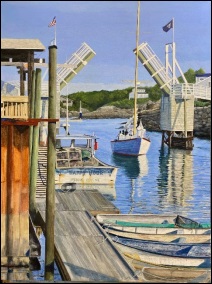
Commercial Fishing Licenses (Single & Crew) | Commercial Lobster/Crab Licenses | Commercial Shellfish Licenses | Total Commercial and Recreational Fishing Licenses |
5 (12 crew) | 19 | 0 | 82 |
Commercial and Recreational Fishing Licenses by Town. (Source: Maine Department of Marine Resources, 2020 license data)
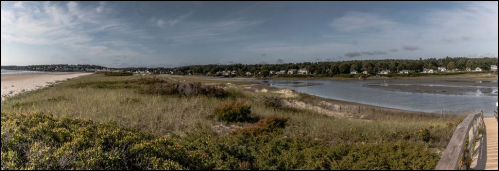
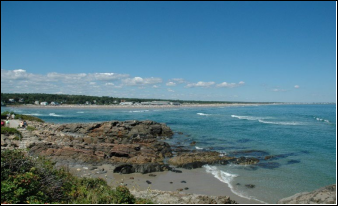
Access to coastal and marine resources is vital for Ogunquit’s residents, businesses, and visitors. There are several parking and access points in town, including the Perkins Cove public parking area and boat launch, Main Beach, Footbridge Beach and North Beach and their municipal parking lots. A 2022 regional coastal vulnerability assessment by SMPDC showed that most of those parking areas are projected to experience flooding from future sea level rise and storms. Main Beach parking lot has 400 spaces and Footbridge Beach and North Beach entrance each have 190 spaces. Handicap parking is available in all public parking lots, plus public toilets. Parking is a significant source of Town revenue.
According to Town documents, Perkins Cove has approximately 83 parking spaces consisting of paid parking, 2-hour free parking as posted, and parking
reserved for commercial activities. There are 43 paid parking spaces limited to three hours maximum and about 26 two-hour free spaces beside the footbridge and in the boatyard. It was noted that parking at Perkins Cove does not meet the area’s demand, and there are no options to expand within the Cove. There is adequate parking for commercial fisherman in the Cove – although the demand is growing as charter boat requirements continue to expand – but not members of the public. There are no opportunities for improved access due to limited land. There are public toilets in the Cove.
Harbor, Marinas, and Vessels
There are no plans to alter
the ramp. Town Ordinances regulate the marine activities within the harbor to ensure the safety of persons and property, to promote availability and use of public resources and to create a fair and efficient framework for the administration of those resources.
There are 68 moorings in Perkins Cove. The maximum length of watercraft (because of safety) in the Cove is 42 feet, as determined in linear feet based upon a measurement from the rearmost part of the watercraft’s transom to the most forward part of the bow stem,
excluding the bowsprit and/or the pulpit. According Moorings at Perkins Cove
to the Town Harbormaster there are 40 large boat moorings and 28 small boat moorings; 36 of the large boat moorings are commercial and four are non-commercial, 11 of the small boat moorings are commercial and 17 are non-commercial. In 2022, the Town received $27,545 in transient dock revenue. The Town ordinances stipulate the allocation of moorings.
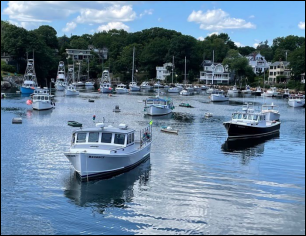
All harbor activities are overseen by the Town Harbormaster, appointed by the Town Manager. The Harbormaster has jurisdiction over all watercraft in the Cove and enforces marine safety rules and regulations based upon the guidelines established by Town Ordinances, the U.S. Coast Guard, and other federal, State or locally recognized authorities. At this time there are no local or regional harbor management plans. There is a yearly evaluation process with the Ogunquit Harbor Committee to identify and plan for the upcoming year including mooring and docking fees, ordinance changes and maintenance of Perkins Cove. As part of the Town budgeting process, the Harbormaster does present a five-year plan for projects such as harbor dredging and repair/replacement of the Perkins Cove bridge. Activities recommended by the Harbormaster include:
- Revitalizecommercial infrastructure including rebuilding the bridge, harbormaster house, and commercial bait house
- Rebuildthe commercial pier to add efficient load/unload space for at least two vessels, where currently there is room for only one.
- Rebuildslipways and winch house and replace all deteriorating old foam style
Dredging
Scenic Vistas
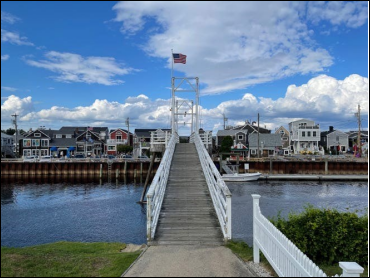
Goals, Policies and Strategies
Goal
- Preserve, protect and promote the Town’s marine resources including shellfish and fisheries habitat, estuaries, shorelands, dunes, coastal waters and water- dependent uses such as Perkins Cove.
Policies:
- Continue to work with the Ogunquit River Watershed Restoration Project toprotect the coastal water quality and marine
- Continueto ensure that Perkins Cove retains its function as a commercial
- To continue to revitalize the infrastructure of the PerkinsCove Harbor (e.g., dredging of the harbor, replace the Perkins Cove Bridge and make it ADA compliant), repair sea wall structures when
- Ensurean equitable balance between commercial and recreational use of the harbor (moorings included).
Strategies:
- Priority: 1-5 with 1 being the highest priority.
| Description | Priority | Responsibility |
| Continue to work with the Army Corps of Engineers, Harbormaster, and Harbor Committee to establish the timeline and cost for surveying and dredging of the Josias River at Perkins Cove. | 1 | Town Manager |
| Participate and continue to work with the Ogunquit River Watershed Restoration Project to develop plans and interventions to protect coastal water quality. Report recommendations to Select Board. | 2 | Conservation Commission |
| Monitor the health of the clam flats and bacteria levels in collaboration with the Department of Marine Resources and Town Shellfish Commission. Make Town and public aware of high bacterial levels and need to close clam flats if necessary. | 3 | Shellfish Commission |
| Implement local harbor management plan including replacing the Perkins Cove Bridge (making it ADA compliant) and repairs to the Harbormaster house. | 4 | Town Manager |
| Continue to work with the Department of Marine Resources (DMR) and Shellfish Commission, to identify any pollutants in clam flats and invasive species such as green crabs. Develop strategy to eradicate invasive species. | 5 | Shellfish Commission |
| Identify needs for additional recreation and commercial marine access (parking, boat launches, docking space etc.). If there are needs identified, conduct a cost analysis to see if the recommendations are viable. | Public Works | |
| Develop a communications strategy to encourage owners of marina businesses to participate in clean marina programs. | Harbor Committee | |
| Prohibit building future piers along the estuary. Revise and adopt municipal codes accordingly. | Planning Board | |
| Evaluate if there is a need to strengthen lobster/fishing/shellfish industries in Ogunquit and make recommendations to accomplish this if necessary. | Shellfish Commission | |
| Work with local property owners to protect major points of physical and visual access to coastal waters, especially along | Town Manager | |
| public ways. Ensure abutting property owners comply. Develop enforcement mechanisms. | ||
| Prohibit power boats from landing/mooring on the beach or dunes. | Harbormaster |